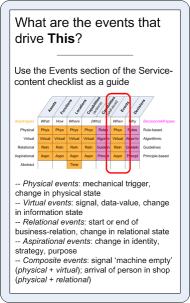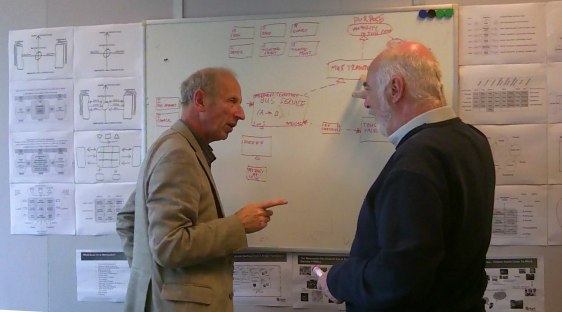Using the ‘This’ game in EA modelling
A great session last Friday with enterprise-architect Stuart Boardman, using his Metropolis thought-experiment as a live test-case for my still somewhat-experimental ‘This’ game for service-modelling.
Stuart developed Metropolis as a worked-example for service-modelling at very large scale – the scale of an entire city. He’s described it in various posts:
- New York as a Virtual Enterprise
- While You Were Sleeping – A New York Story
- Metropolis – Slight Return
- Enterprise Transformation, Innovation, Emergence and the Sewers of Vienna (Open Group weblog)
(He also included it in his presentation for the Open Group conference in Cannes, back in April, but I don’t have a link for that.)
The ‘This’ game is a technique I developed for collecting information about services, at various levels of abstraction, and mapping them out using the simplified Enterprise Canvas notation and the Enterprise Canvas service-viability checklist. It consists of a bunch of questions, clustered into related groups, and each presented on a metaphoric or even literal card:
Anyway, this is what it looked like when Stuart (on the left) and I (the other one, obviously) started to put it all together on the whiteboard:
The immediate problem, or challenge, or whatever, is that at present the This game assumes a lot of prior knowledge. That’s all those diagrams on either side of the board: sixteen of them, to be precise – and that was the smallest subset that I could trim it all back to. (Stuart’s summaries for his Metropolis concept are lined up below the whiteboard.)
Stuart’s fairly familiar with my work, but even so it took well over an hour just to describe all of the diagrams and the part that they each play in the overall modelling process. That’s a lot – far too much for most people, especially for a one-off project like this one. All of the diagrams do have real importance, explaining key points that need to be included in modelling, but it’s clear I do need to do another round of simplifying everything. More than one round of it, probably. Oh well.
Anyway, once we got started, all that preparation really paid off, because the ideas flowed quick and fast. I’m glad we recorded it all on video, because there’s much, much more in the discussion than ended up in the rather sparse examples shown on the whiteboard.
One of the key points was the ‘start anywhere‘ principle. When faced with a huge multi-party enterprise, it seems almost impossible to decide where to start. But if, as in Enterprise Canvas, we say that everything is or represents a service, and also that everything ultimately connects with everything else, then in effect it doesn’t matter where we start – anywhere will do, because it’s connected to everything else.
So, just pick somewhere. In this case, Stuart chose as his starting-point the idea of ‘Bus Service (A to B)’. And after a bit of wandering, as guided by the This cards, we ended up with what can be (just about) seen on the board. For example, ‘Bus Service (A to B)’ is instantiated as ‘#9 Bus Route’, and further realised as ‘#9 Bus Route, 10:15am, RouteMaster 4056, driver Fred Higgins’, all of which connects to the overall-enterprise value of ‘safe, reliable, economical public-transport around the city’, and (here) links to a whole bunch of other services as shown up at the top and left-side of the board.
Some lessons-learned: it takes a lot longer than we’d expected. At present there are some 70-odd cards in the This stack, which I’d shuffled into random order; but in the couple of hours we had available, I doubt we went through more than about ten of them, and all of that was (in principle) just for that one service at the starting-point. But it’s not as bad as it sounds: each of those cards triggered off at least ten minutes or so of intense discussion and idea-generation – which was the real purpose of the exercise. So at the end, not much of a model, but a lot of very good ideas – all of which we had captured on video as we went along.
Overall, though, I’d say it was a success – a good challenge, and a good test. More still to do, though, to clean it all up and make it more usable than at present. Watch this space, perhaps?
[Many thanks to KPN Zoetermeer for the loan of the workspace, and to Tom van Sante for a great lunchtime conversation! 🙂 ]


Leave a Reply